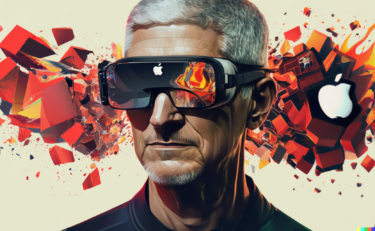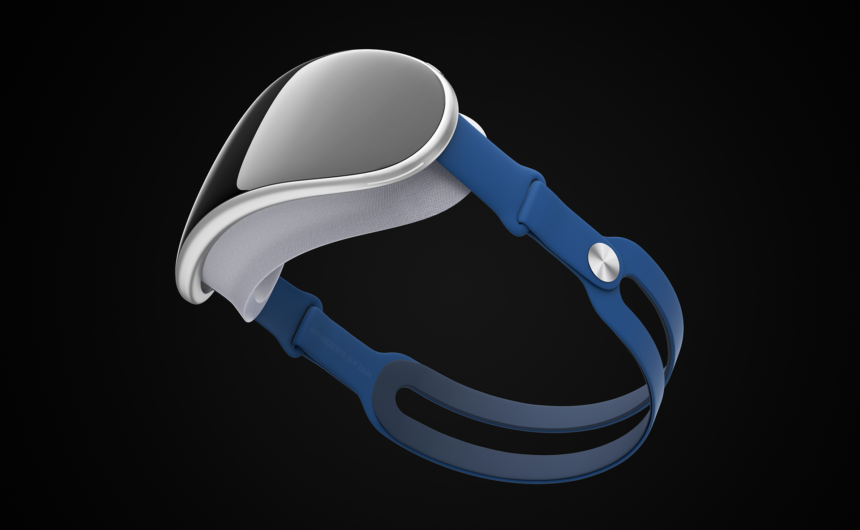Massive Apple headset leak reveals new details and confirms earlier rumors

Apple's possible XR headset reportedly has a quick dial for changing realities and many other features. The killer app is said to be realistic avatar XR video calls.
The Information claims to have once again received insider information from sources close to Apple who are familiar with the development of Apple's XR headset. The report contains numerous technical details about the headset, including new information.
The most important points in the overview:
- Apple's XR headset is said to be built from aluminum, glass and carbon fiber and is compact and lightweight.
- The headset draws power from a waist mounted battery, which can be replaced during operation. This design is said to have been thought up by Apple's former chief designer Jony Ive.
- Built in are two processors, a main SoC (M2) and for video processing (ISP), both made in a 5 nm process and offering a proprietary streaming codec.
- The ISP is said to stream and de-warp the distorted external image from the integrated cameras into the headset with low latency. This is crucial for high-quality mixed reality applications. Here, Apple's acquisition of NextVR could pay off; there have been similar rumors before. The chip is supposed to use a custom-built, fast working memory from SK Hynix.
- Additionally, an H2 chip is integrated for ultra-low latency audio transmission to Apple's AirPod Pros. Conventional Bluetooth headphones are not supposed to work optimally, and there is no jack plug.
- However, the headband has integrated speakers, but their sound is audible to outsiders, which can be a problem in terms of privacy. It is said to be made of a similar material to that of the Apple Watch's sports wristbands. For developers, there is supposed to be an alternative headband that can be connected to a Mac.
- A quick dial comparable to the Apple Watch is supposed to enable a quick switch between the virtual and physical world. The button does not offer haptic feedback.
- Corrective lenses can be inserted into the headset via magnets if the user is visually impaired.
- The lens distance is automatically adjusted to the eye distance of the headset wearer via an integrated motor.
- The field of view is said to be 120 degrees, which would be slightly wider than the Meta Quest Pro's 106 degrees and significantly wider than open AR headsets like Magic Leap 2 or Hololens (around 50 degrees).
- Apple is said to prefer hand tracking as an interface, but is experimenting with alternative input devices such as a wand and a kind of thimble.
- Games are not the focus for Apple, and a gaming controller is not included. Pure VR experiences are to be offered via the game engine Unity as a partner company.
- The Apple headset can display existing iOS apps in 2D.
Apple bets on XR video calls as 'killer app' and offers outsiders headset face
The Information confirms some earlier rumors, including that the headset will have an outward-facing display that shows outsiders the facial expressions of the headset wearer. This feature is supposed to reduce the feeling of isolation when the headset is put on. The screen is said to consume little power and offer a low refresh rate, comparable to the Apple Watch's always-on mode.

Concept rendering of the Apple headset, which is supposedly based on a prototype, but does not show many of the technical details like cameras. | Bild: Ian Zelbo
The Information confirms that Apple will use a 4K micro OLED display from Sony for the center of the image per eye. This is complemented by an LG display in the peripherals, according to earlier rumors. Eye tracking including foveated rendering is also integrated, which saves power by only rendering the user's exact focus point with all graphic details.
In total, the headset is said to have two LiDAR scanners for short and long distances and more than a dozen inward and outward cameras built in, even detecting the legs of the person using the headset.
In addition to education, one focus of the headset is said to be XR video conferencing with realistic avatars that accurately reflect facial and body movements. Eyebrow and jaw movements of the avatar are to be estimated by an AI process based on available sensor data.
Apple also wants to enable a transition between the Mac screen and the XR display: If you pull the 2D Maps app from the Mac screen, it can show a 3D model of a city in XR mode.
Depending on the configuration, the headset is expected to cost around $3,000. Apple's contract manufacturer Pegatron is said to have built several thousand prototypes last year, and the launch was originally planned for 2022.
Note: Links to online stores in articles can be so-called affiliate links. If you buy through this link, MIXED receives a commission from the provider. For you the price does not change.